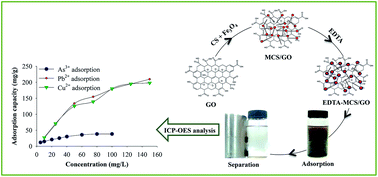Heavy metals removal by EDTA-functionalized chitosan graphene oxide nanocomposites†
Abstract
Graphene-based two-dimensional materials have been explored in a variety of applications, including the treatment of heavy-metal-rich water/wastewater. Ethylenediaminetetraacetic acid (EDTA)-functionalized magnetic chitosan (CS) graphene oxide (GO) nanocomposites (EDTA-MCS/GO) were synthesized using a reduction precipitation method and applied to the removal of heavy metals, such as Pb2+, Cu2+, and As3+, from aqueous solutions. The synthesized nanocomposite was characterized by FT-IR, XRD, SEM, MPMS, zeta-potential and BET analyses. The influence of various operating parameters, such as pH, temperature, metal ion concentration, and contact time on the removal of the metal ions, was investigated. Owing to the large specific surface area, hydrophilic behavior, and functional moieties, the magnetic nanocomposite demonstrated excellent removal ability with a maximum adsorption capacity of 206.52, 207.26, and 42.75 mg g−1 for Pb2+, Cu2+, and As3+, respectively. The equilibrium data was evaluated by Langmuir and Freundlich isotherms, while the heavy metal adsorption reaction kinetics was analyzed by Lagergren pseudo-first-order and pseudo-second-order kinetic models. The nanocomposite was reused in four successive adsorption–desorption cycles, revealing a good regeneration capacity of the adsorbent.

- This article is part of the themed collections: Adsorption and degradation of pollutants, Editors’ collection: Graphene and RSC Advances: Most downloaded articles of 2017


 Please wait while we load your content...
Please wait while we load your content...